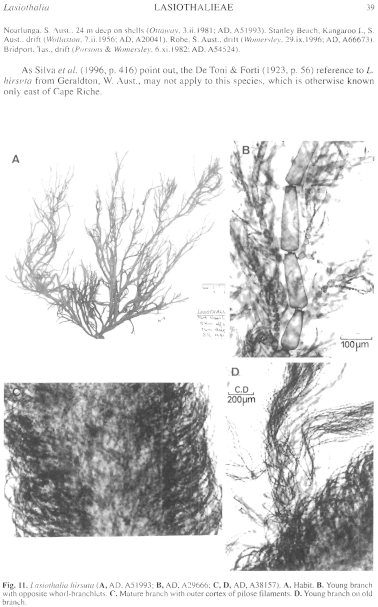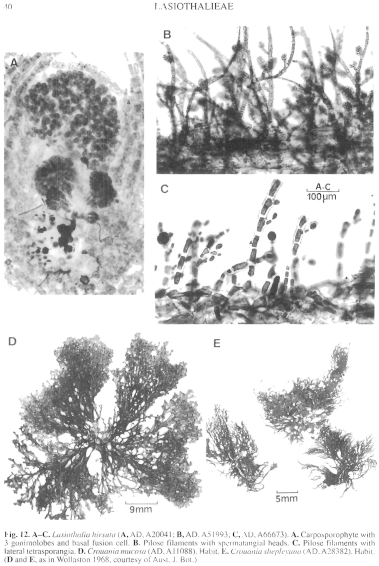|
|
|
|
|
|||||||||||
|
Electronic Flora of South Australia Species Fact Sheet
Phylum Rhodophyta – Order Ceramiales – Family Ceramiaceae – Tribe Lasiothalieae
Selected citations: J. Agardh 1876: 45; 1892: 40. De Toni 1903: 1420. Kylin 1956: 385, 395. Lucas 1909: 52; 1929a: 25. Lucas & Perrin 1947: 357. Schmitz & Hauptfleisch 1897: 499. Silva et al. 1996: 416. Wollaston 1990: 23, figs 14–19, 24–25, 27, 28.
Thallus (Fig. 11A) erect, red brown to grey brown, 10–20 (–30) cm high, with irregularly branched, densely corticated axes, with an inner entwined rhizoidal layer and an outer pilose layer (Fig. 11C) of unbranched filaments, ecorticate near the apices only (Fig. 11B, D). Holdfast rhizoidal, 3–8 (–12) mm across, epilithic. Structure. Axial cells 100–250 wn in diameter and L/D 2–6 in mid thallus, to L/D 10–20 in lower parts, each cell bearing first a single and later an opposite (usually less well developed) lateral branchlet (Fig. 11B), each furcate several times and usually with a smaller basal cell; these branchlets soon obscured by the cortication. Rhizoidal filaments from the lower cells of branchlets form a dense cortical layer, often anastomosing, with each cell producing a determinate, simple, outwardly projecting filament which is curved upwardly (Fig. 13A), 8–20 µm in diameter, 150–700 µm long, cells L/D 1–2.5. Denuded plants, without growing tips and pilose filaments, are frequent; gland cells absent. Cells uninucleate; rhodoplasts discoid in smaller cells, ribbon like in larger axial cells.
Reproduction: Gametophytes dioecious. Procarps (Fig. 13C) borne near the tips of pilose cortical filaments (Fig. 13B), single or on several successive cells with the uppermost procarp usually on the third cell from the apex; the supporting cell, which bears the 4-celled carpogonial branch, is the basal cell of a short lateral branch 3–4 cells long, borne on the axial cell of the pilose filament. Post-fertilization the supporting cell cuts off an auxiliary cell and the carposporophyte (Figs 12A, 13D) consists of successive rounded groups 120–180 µm across of ovoid carposporangia 12–25 µm in diameter; the supporting cell, axial cell of the pilose branchlet and part of the lower axial cell fuse, but no involucral branchlets are produced. Spermatangial heads (Figs 12B, 13E) are borne on pilose cortical filaments and on lateral branchlets, each ovoid and 20–40 µm in diameter, L/D 1.5–2.5, with a basal pedicel and axis of 3–6 cells bearing whorls with terminal spermatangia 1–2 µm in diameter.
Tetrasporangia (Fig. 12C) are borne on short lateral branches of the pilose filaments, sessile or usually on 1–2-celled pedicels, subspherical, 35–55 µm in diameter, tetrahedrally divided.
Type from Cape Riche, W. Aust.; holotype in TCD (Harvey, Tray. Set 321).
Selected specimens: Investigator Strait, S. Aust., 41 m and 33 m deep (Watson, 14.i.1971 and 24.i.1971; AD, A38157 and A41090 respectively). Brighton, S. Aust., drift (Bienert, 12.xi.1965; AD, A29666). Port Noarlunga, S. Aust., 24 m deep on shells (Ottaway, 3.ii.1981; AD, A51993). Stanley Beach, Kangaroo I., S. Aust., drift (Wollaston, 7.ii.1956; AD, A20041). Robe, S. Aust., drift (Womersley, 29.ix.1996; AD, A66673). Bridport, Tas., drift (Parsons & Womersley, 6.xi.1982; AD, A54524).
Distribution: Cape Riche, W. Aust., to Robe, S. Aust., and N coast of Tasmania.
Taxonomic notes: As Silva et al. (1996, p. 416) point out, the De Toni & Forti (1923, p. 56) reference to L. hirsuta from Geraldton, W. Aust., may not apply to this species, which is otherwise known only east of Cape Riche.
References:
AGARDH, J.G. (1876). Species Genera et Ordines Algarum. Vol. 3, Part 1- Epicrisis systematic Floridearum, pp. i-vii, 1–724. (Weigel: Leipzig.)
AGARDH, J.G. (1892). Analecta Algologica. Acta Univ. lund. 28, 1–182, Plates 1–3.
DE TONI, G.B. & FORTI, A. (1923). Alghe di Australia, Tasmania e Nouva Zelanda. Mein. R. Inst. Veneto Sci., Lett. Arti 29, 1–183, Plates 1–10.
DE TONI, G.B. (1903). Sylloge Algarum omnium hucusque Cognitarum. Vol. 4. Florideae. Sect. 3, pp. 775–1521 + 1523–1525. (Padua.)
HARVEY, W.H. (1855a). Some account of the marine botany of the colony of Western Australia. Trans. R. Jr. Acad. 22, 525–566.
HARVEY, W.H. (1859b). Algae. In Hooker, J.D., The Botany of the Antarctic Voyage. III. Flora Tasmaniae. Vol. II, pp. 282–343, Plates 185–196. (Reeve: London.)
KYLIN, H. (1956). Die Gattungen der Rhodophyceen. (Gleerups: Lund.)
LUCAS, A.H.S. & PERRIN, F. (1947). The Seaweeds of South Australia. Part 2. The Red Seaweeds. (Govt Printer: Adelaide.)
LUCAS, A.H.S. (1909). Revised list of the Fucoideae and Florideae of Australia. Proc. Linn. Soc. N.S.W. 34, 9–60.
LUCAS, A.H.S. (1929a). The marine algae of Tasmania. Pap. Proc. R. Soc. Tasm. 1928, 6–27.
SCHMITZ, F. & HAUPTFLEISCH, P. (1897). Ceramiaceae. In Engler, A. & Prantl, K., Die natarlichen Pflanzenfamilien, Vol. 1, Part 2, pp. 481–504. (Leipzig.)
SILVA, P.C., BASSON, P.W. & MOE, R.L. (1996). Catalogue of the Benthic Marine Algae of the Indian Ocean. (University of California Press: Berkeley, Los Angeles & London.)
WOLLASTON, E.M. (1990). Recognition of the genera Spongoclonium and Lasiothalia Harvey (Ceramiaceae, Rhodophyta) in southern Australia. Bot. Mar. 33, 19–30.
The Marine Benthic Flora of Southern Australia Part IIIC complete list of references.
Publication:
Womersley, H.B.S. (24 December, 1998)
The Marine Benthic Flora of Southern Australia
Rhodophyta. Part IIIC. Ceramiales – Ceramiaceae, Dasyaceae
©State Herbarium of South Australia, Government of South Australia
Illustrations in Womersley Part IIIA, 1998: FIGS 11, 12 A–C, 13 A–E.

Figure 11 enlarge
Fig. 11. Lasiothalia hirsuta (A, AD, A51993; B, AD, A29666; C, D, AD, A38157). A. Habit. B. Young branch with opposite whorl-branchlets. C. Mature branch with outer cortex of pilose filaments. D. Young branch on old branch.

Figure 12 enlarge
Fig. 12. A–C. Lasiothalia hirsuta (A, AD, A20041; B, AD, A51993; C, AD, A66673). A. Carposporophyte with 3 gonimolobes and basal fusion cell. B. Pilose filaments with spermatangial heads. C. Pilose filaments with lateral tetrasporangia. D. Crouania mucosa (AD, A 11088). Habit. E. Crouania shepleyana (AD, A28382). Habit. (D and E, as in Wollaston 1968, courtesy of Aust. J. Bot.)

Figure 13 enlarge
Fig. 13. A–E. Lasiothalia hirsuta (AD, uncertain). A. Axial cells, with opposite whorl-branchlets bearing ascending and descending cortical rhizoids with outward, curved, pilose filaments. B. Indefinite pilose filaments bearing young carpogonial branches. C. Carpogonial branches near the apex of a pilose filament. D. A carposporophyte with 4-5 lobes of carposporangia. E. Pilose filaments with spermatangial heads. F–L. Crouania mucosa (AD, Al 1088). F. Thallus with new axial branches arising below older apices. G. Carpogonial branch (with spermatium on trichogyne) and supporting cell on an axial cell. H. Female thallus with clavate branch apices bearing carposporophytes. I. Carposporophyte with mature and young gonimolobes arising from central cell. J. Whorl-branchlet bearing spermatangia. K. Thallus with tetrasporangia. L. Cross section of branch with tetrasporangia. (All as in Wollaston 1990, courtesy of Bot. Mar. and 1968, courtesy of Aust. J. Bot.)

|
Email Contact: State Herbarium of South Australia |

|